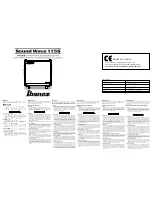
L-ACOUSTICS V-DOSC Manual Version 4
6/29/2005
Page 124 of 158
The desired overall tonal balance depends on both the music program material and the target SPL.
For typical rock concerts, sound pressure levels are 102-105 dBA continuous (A weighted) and
125-130 dB SPL (peak unweighted). The only harmless way to reach such levels is to increase the
sub/low contour since significant increases in the A-weighted SPL would eventually become painful
for the audience (and possibly illegal).
In general, sub/low and high frequency tonal balance contours result in a more mix-friendly system
for modern music – however, the influence such a system contour has on your board tapes is a
another topic for discussion. To a large extent, tonal balance contours are a matter of subjective
taste and personal preference that is related to where the FOH engineer prefers to set his mix
balance – on the channel strip or on the main PA. Some engineers prefer a built-in low end bump
in the PA, others prefer a flat system and using the “warmth of the channel strip” on the console.
For program material with lower overall SPL requirements (e.g., speech and classical music),
changing a traditionally ‘flat’ tonal balance by boosting the low end is not desirable since peak
levels occur only during very short musical transients and the Leq is much lower – typically 95
dBA, or less. In addition, a prominent bass response would not be accepted from an artistic point
of view by most classical music conductors or performers and the audience. In order to obtain
nominally flat response for speech or classical music sound reinforcement, mid/high ratios will
have to be scaled up by approximately 6-8 dB and/or the low/sub output gains attenuated
(depending on the size of the array). At the opposite end of the spectrum, for heavy metal shows
sub/low contours (below 100 Hz) tend to be 30 dB higher than the nominal mid/high response.
Due to it’s coplanar symmetric design, V-DOSC has very stable frequency response throughout
it’s coverage region and equalization adjustments made at the mix position translate well
throughout the audience. When properly installed and focussed, room-related effects above 300
Hz are minimized and consistent system performance from venue-to-venue effectively allows V-
DOSC to serve as an accurate reference monitor for the FOH engineer. At lower frequencies,
array coupling and room-related effects will typically require equalization in the 120-300 Hz range
and it is important to “walk the room” and/or perform spatial averaging measurements to ensure
that system equalization adjustments are valid throughout the coverage region of a given array.
Due to system phase coherency, small equalization adjustments are highly audible, i.e., you can
hear the system respond to eq as well as to adjustments on the mixing console. If you find that it is
necessary to apply excessive amounts of equalization to the system above 300 Hz, it is advised to
double check the system installation (angle strap selection, ratchet strap tensioning, system focus
and whether FOH L/R arrays are correctly matched). In addition, a common problem with FOH
engineers who are unfamiliar with V-DOSC is the tendency to over-equalize the mid section since
they are unaccustomed to the nearfield listening experience over this frequency bandwidth. The
CVE or QVT accompanying the V-DOSC system should attempt to dissuade over-equalization and
educate the guest engineer whenever possible. A better solution is not to equalize the mid band
but to simply reduce the level of vocals etc in the mix.
Several strategically-placed parametric notches can be highly effective in compensating for room
reverberation modes and for better resolution, it is recommended that the parametric filters
available on the inputs of the digital signal processor are used for system eq. In a festival situation,
an effective approach is to perform system equalization using the input parametric filters then turn
the system over to the guest FOH engineer with house graphic eqs set flat. Typically, guest
engineers are more comfortable with a graphic eq for quick adjustments on the fly and after each
act, the graphic can be reset for the next engineer.
System predelay is commonly used to improve the combined integration of the main FOH system
with the sound coming from onstage. In some cases, alignment with the instrument backline
(guitar amplifier stacks, kick drum) is effective and the distance can be determined geometrically
(think Fresnel!). In other cases, time alignment with the drum monitor, sidefill monitors or the
monitor front line may prove more effective. Generally, the loudest thing on stage makes for a
good time alignment reference. In smaller venues, where monitor system energy reflects off the
back wall and ceiling in addition to the direct sound generated by the band, system predelay is not
Summary of Contents for V-DOSC
Page 1: ...Version 4 June 2005 V DOSC OPERATOR MANUAL ...
Page 2: ...L ACOUSTICS V DOSC Manual Version 4 6 29 2005 Page 2 of 158 ...
Page 116: ...L ACOUSTICS V DOSC Manual Version 4 6 29 2005 Page 116 of 158 a b c d e f g h ...
Page 117: ...L ACOUSTICS V DOSC Manual Version 4 6 29 2005 Page 117 of 158 i j k l m n o p ...
Page 118: ...L ACOUSTICS V DOSC Manual Version 4 6 29 2005 Page 118 of 158 q r s t u v w x ...
Page 156: ...L ACOUSTICS V DOSC Manual Version 4 6 29 2005 Page 156 of 158 ...
Page 157: ...L ACOUSTICS V DOSC Manual Version 4 6 29 2005 Page 157 of 158 ...
Page 158: ...L ACOUSTICS V DOSC Manual Version 4 6 29 2005 Page 158 of 158 ...
















































